By Eric Lindstrom
The central mooring at the SPURS site is a critical piece of gear. It will provide us with a time series of upper ocean properties at one location over the entire year. We’ll build the other SPURS measurements around this spot on this and future voyages. We’ll “fly” the gliders in patterns centered on this location.
Our first order of business is to survey the bottom depth in the vicinity of the proposed mooring location (near 25N, 38W). The water depth we are aiming for is near 17,390 feet (5,300 meters).
The mooring is anchored to the bottom (with a 10,000 pound anchor). A large, heavily-instrumented buoy at the surface holds the entire string of instruments below. Just above the anchor is an acoustic release mechanism that can disengage the mooring from the anchor on command from the ship next year. Above the release are 80 glass floats (inside hardhats) that serve to float the bottom of the mooring to the surface after release.
It’s a process of many hours to deploy the mooring. The ship will position itself some miles from the proposed anchoring site (depending on wind and currents) and start steaming toward the spot very slowly. The length of mooring and gear are then deployed over the stern starting with the top of the mooring, the surface buoy. After that various current meters, salinity and temperature sensors are attached in turn with various lengths of chain and shackles. As they are joined, they are in turn lowered over the stern and the surface buoy begins to distance itself in the ship’s wake. About 8 hours after the start of the deployment, the 16,000 feet of mooring is laid out on the surface behind the ship, and all that’s left on deck is the anchor.
At this point, location is everything. If timed correctly, the ship will be some distance past the location mooring intended to land on the bottom (say 10 percent of the water depth). If so, it is time to drop the anchor. As it falls, the length of mooring will drag it back toward the spot it will finally come to rest. We will see the surface buoy begin to rush swiftly back toward the ship (hopefully finishing up at its intended target location).
Such work has been done thousands of times over the decades, but every deployment presents its own challenges of ocean bottom topography, wind, currents, and equipment. The length of the mooring needs to precisely cut for the water depth in which it is anchored. If it is too long, the mooring swings around too much at the surface. If it is too short, the mooring may be under too much stress or snap.




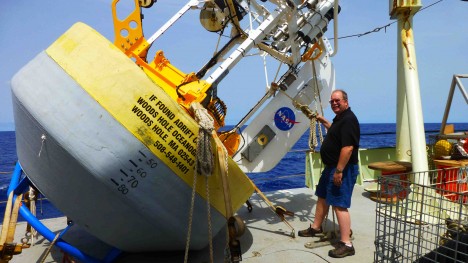

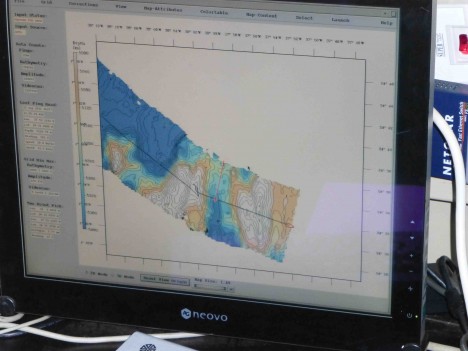
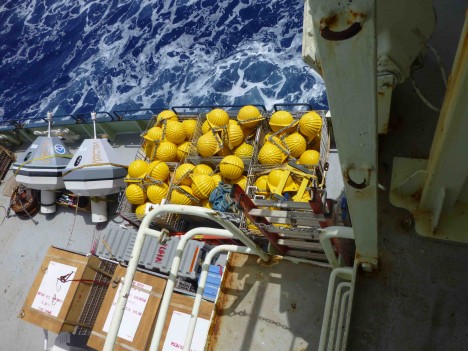
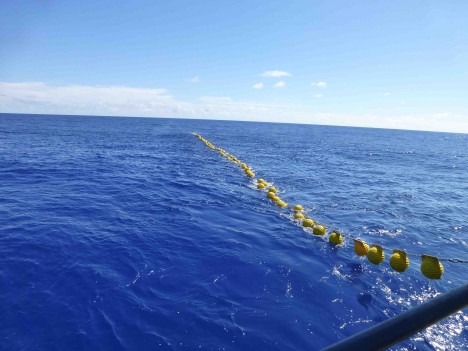
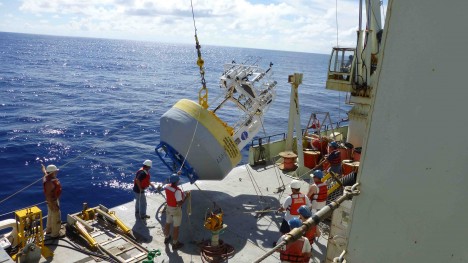
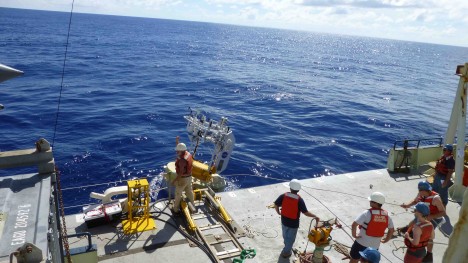
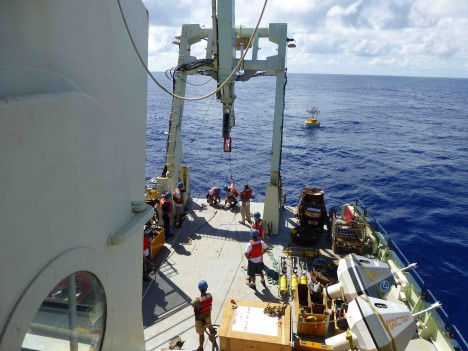
Hi Eric! So exciting that the moorings are being deployed, congrats to all of you! I have a question about the floats…why use glass floats protected in hard hats? Why not just make some sort of plastic float/buoy? Just interested. Thanks!
Hi Phoebe,
That is an excellent question. Let me explain the role of the 80 glass floats in hard hats.
The glass floats are at the bottom of the ocean (~17000 feet) just above the release mechanism. The idea is to have enough buoyancy at the bottom of the mooring to bring the bottom end to the surface in case the surface buoy is lost and for ease of recovery if things go well (the bottom end is where you would like to start recovery operations).
The surface buoy is the part most at risk from weather, ship strike, vandalism, etc. And the most likely place for the mooring to break is right under the surface buoy where wave action keeps parts moving and wearing. IF the surface buoy is lost, ALL the instruments suspended below the surface buoy (mostly in the top 1000 feet of ocean) will fall to the sea bottom. They can still be recovered later because of the glass floats in hard hats are at the bottom of the string. All the instruments on the mooring are built to withstand the pressures found at the ocean bottom, so data collected before the loss of the surface buoy is recoverable.
Why hard hats? The glass floats are precision-built spheres designed to withstand great pressure. Any scratch or imperfection could lead to their implosion at depth. The force of one imploding is known to be enough of a disturbance to cause other nearby floats to fail. However, loss of a few glass floats will not deter recovery operations. The hard hats provide secure points to chain the glass floats together as well as much needed protection during their lifetime of service.
I hope that answers your question!
Eric
Date: 18/09/2012
Hello and thank you for the opportunity to communicate with interested parties and experts on the SPURS project and scientists on board the Knorr research vessel.
I am Alba Ragone, a research scientist in the department of Civil Engineering, at Glasgow Strathclyde University in Scotland UK. Working on a project called “link between seawaters salinity changes and Octanol-water partition coefficient for POPs”.
Therefore, I am following SPURS progress and data update with absolute interest; and as your project is collecting actual, site-specific data (salinity, pH and temperature changes) in Marine waters. Consequently, I would like to ask the following questions.
1) Is the SPURS project, is analyzing Persistent Organic Pollutants (POPs) levels in your Seawater samples?
2) If sampling for these compounds is outside SPURS’ agenda, is it possible for the SPURS project to collect water samples and send these to us for analysis, at Glasgow Strathclyde University.
Analyzing actual Sea and Oceanic-water, sampled at different locations for the presence of POPs, would help further environmental research on the trans-boundary dispersion of POPs by means of the Sea and Oceanic waters currents’. Therefore, the SPURS expedition to the Atlantic Ocean “Saltiest Spot”; and program for sampling and data collection, together with the subsequent expedition in 2015 to areas of “low saltiness” is a very important, and could facilitate collection of additional data.
I thank you very much for your kind attention and look forward to your correspondence.
Yours sincerely,
Alba Ragone
Alba,
Thank you for your interest in SPURS. Its not very often that a research vessel gets out to study the saltiest water in the North Atlantic! In the spirit of scientific cooperation and opportunity, we are interested in helping you. However, we will need to know more about the sampling requirements and protocol and thereafter assess our ability to meet the need and return useful samples. I will be in contact via email for further discussion of the details.
Eric